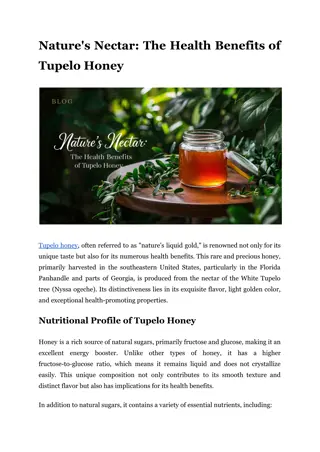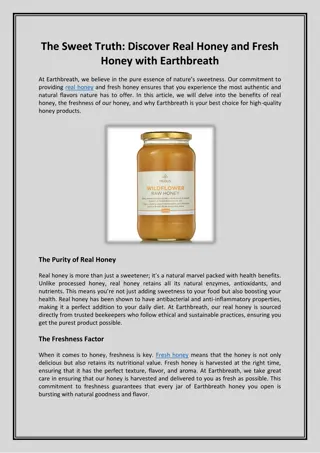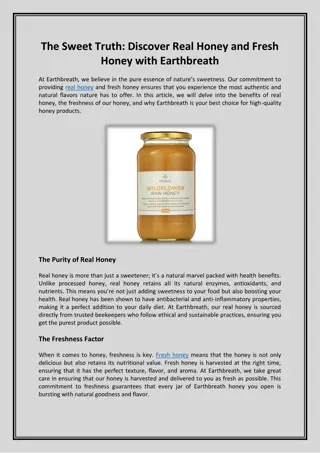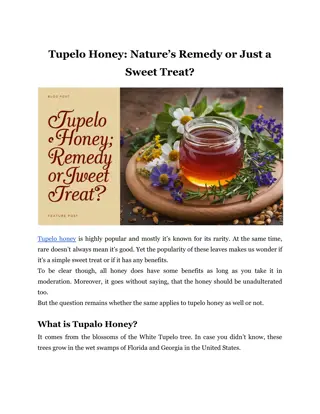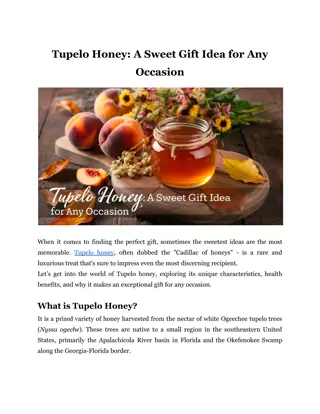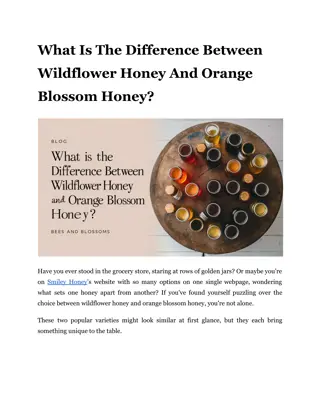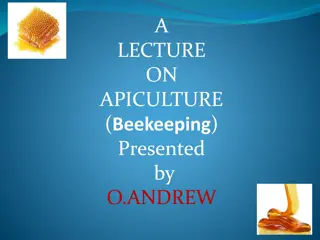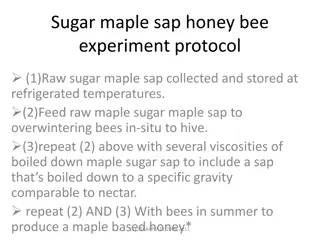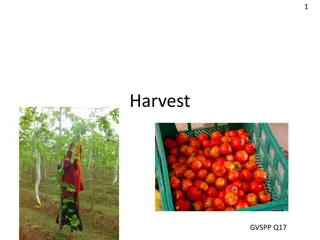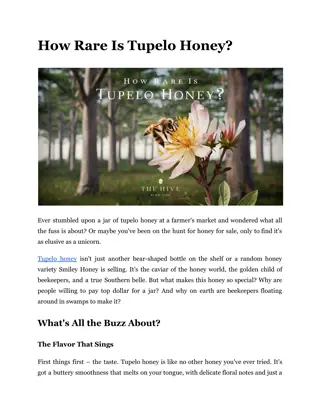
The Art of Harvesting Tupelo Honey: A Sweet Symphony of Tradition and Sustainabi
Discover the art of harvesting Tupelo honey, blending tradition with sustainability for a unique and delightful taste experience.
Download Presentation

Please find below an Image/Link to download the presentation.
The content on the website is provided AS IS for your information and personal use only. It may not be sold, licensed, or shared on other websites without obtaining consent from the author. If you encounter any issues during the download, it is possible that the publisher has removed the file from their server.
You are allowed to download the files provided on this website for personal or commercial use, subject to the condition that they are used lawfully. All files are the property of their respective owners.
The content on the website is provided AS IS for your information and personal use only. It may not be sold, licensed, or shared on other websites without obtaining consent from the author.
E N D
Presentation Transcript
The Art of Harvesting Tupelo Honey: A Sweet Symphony of Tradition and Sustainability Deep in the swamps of the southeastern United States, a golden elixir is born. Tupelo honey, often called the "champagne of honeys", is a rare and coveted treasure that nature offers for just a few precious weeks each year. This isn't just any honey it's a testament to the delicate dance between humans, bees, and the environment. From the strategic placement of hives on precarious platforms in swampy waters to the meticulous timing required for harvest, the production of Tupalo honey is nothing short of an art form. But it's an art under threat, facing challenges from climate change, habitat loss, and economic pressures.
The Tupelo Tree is The Nature's Own Sweet Factory At the heart of its production is the white tupelo tree (Nyssa ogeche), a species that thrives in the swampy, waterlogged conditions of river basins in the Florida Panhandle and southern Georgia. These trees are not just flowering plants; they're the exclusive source of true tupelo honey. The short blooming period of tupelo trees is what makes this honey so rare and valuable. Beekeepers have a narrow window to capture this unique nectar, making the harvest a high-stakes operation. Read More Articles: Sourcing Authentic Tupelo Honey: Tips for Finding the Best The Harvesting Process Honey harvesting is a meticulous process that requires precision, experience, and a deep understanding of the local ecosystem. Here's a step-by-step breakdown of this intricate art: 1. Hive Placement: Beekeepers strategically position their hives along riverbanks or on floating platforms called "bee barges." This ensures the bees have direct access to the blooming tupelo flowers. 2. Timing is Everything: As soon as the white tupelo trees begin to bloom, beekeepers must strip the bee colonies of all existing honey stores. This prevents contamination with other types of nectar, thus ensuring the honey s purity. 3. The Bloom: For a brief 2-3 week period, bees work tirelessly to collect nectar from the tupelo blossoms. Beekeepers monitor the bloom closely, as weather conditions can significantly impact nectar production.
4. Harvest: Once the flowers fade, beekeepers promptly remove the hives and extract the honey. Speed is crucial to maintain the honey's purity and prevent mixing with other nectar sources. 5. Processing: The extracted honey is minimally processed to preserve its unique flavor profile and natural properties. The Unique Properties of Tupelo Honey It stands out from other varieties due to its distinctive characteristics: 1. Flavor Profile: Described as light, buttery, and floral with hints of fruit and a subtle vanilla aroma. Its taste is uniquely smooth and mild, setting it apart from other honey varieties. 2. Non-Crystallizing Nature: Due to its high fructose-to-glucose ratio, it rarely crystallizes, maintaining its liquid state even at cooler temperatures. 3. Color: It has a light gold color with a slight greenish tint, a visual indicator of its uniqueness. 4. Nutritional Value: Like other raw honey, it contains multiple antioxidants and has potential antibacterial properties. Its specific composition may offer unique health benefits, though more research is needed in this area.
Challenges and Threats to Tupelo Honey Production Despite its revered status, the production of tupelo honey faces several significant challenges: 1. Climate Change: Shifting weather patterns and increased frequency of extreme weather events threaten the delicate balance required for successful production. 2. Habitat Loss: Development and changes in land use are encroaching on the natural habitats of tupelo trees, reducing the available areas for honey production. 3. Economic Pressures: The unpredictability of good harvest years makes it economically challenging for beekeepers to rely solely on tupalo honey production. 4. Bee Health: Like all honey production, it is dependent on healthy bee populations, which face threats from pesticides, diseases, and habitat loss. Read More Articles: Sourcing Authentic Tupelo Honey: Tips for Finding the Best Sustainability Efforts 1. Habitat Conservation: Organizations are working to protect and restore the swampy habitats where tupelo trees thrive. This includes efforts to mitigate the impacts of climate change on these ecosystems.
2. Sustainable Beekeeping Practices: Beekeepers are adopting methods that prioritize bee health & environmental sustainability, such as rotating hive locations and supporting biodiversity. 3. Community Engagement: Local communities and organizations are actively involved in raising awareness about the importance of protecting tupelo habitats and supporting sustainable honey production. 4. Research and Innovation: Ongoing studies aim to better understand its unique properties and develop more resilient beekeeping practices. Preserving Nature s Liquid Gold The art of harvesting tupelo honey is a testament to the intricate relationship between humans and nature. This rare and precious honey is more than just a sweet treat; it's a reflection of a unique ecosystem, a cultural tradition, and the delicate balance required to produce something truly extraordinary. Takeaway As we face environmental challenges, it becomes increasingly important to support sustainable practices and conservation efforts. By choosing responsible producers, we can play a part in preserving this natural treasure for future generations. With a commitment to traditional harvesting methods and environmental stewardship, our team at Smiley Honey ensures that each jar of tupelo honey for sale not only delights the palate but also contributes to the preservation of this unique honey-producing ecosystem.
Site Article: The Art of Harvesting Tupelo Honey: A Sweet Symphony of Tradition and Sustainability




